Navigate
Find by Name
Drawing Options
Grid
Label
Photometric objects
Objects with spectra
Invert Image
Label
Photometric objects
Objects with spectra
Invert Image
Advanced Options
APOGEE Spectra
SDSS Outlines
SDSS Bounding Boxes
SDSS Fields
SDSS Masks
SDSS Plates
SDSS Outlines
SDSS Bounding Boxes
SDSS Fields
SDSS Masks
SDSS Plates
Image Source
Selected Object
SDSS ID:
SDSS ID:
| ra | 179.71819 |
| dec | -0.45674 |
| type | STAR |
| u | 15.51 |
| g | 13.51 |
| r | 12.88 |
| i | 12.69 |
| z | 13.76 |
Quick Look
Explore
Recenter
Add to notes
Show notes
Analyze Spectrum
Famous Places in Navigate
Below are some of the most interesting and beautiful objects in the night sky, for you to explore with Navigate. Enjoy!
Galaxies
The Sloan Digital Sky Survey has taken images of more than 50 million galaxies,
from giant spirals to tiny smudges of light. Here are some of the most beautiful.
NGC 450
NGC 450
and a companion. Although the two galaxies appear to form a pair, they are
actually at much different distances. The smaller, fainter object is 7 times farther away.


NGC 5792
NGC 5792
, a spiral galaxy that we see nearly edge-on. The bright red star is in the
Milky Way, very, very close to us compared to the distant galaxy. The star makes a colorful
counterpart to the blue galaxy, although the two are unrelated.


NGC 4437
NGC 4437
, a spectacular edge-on spiral galaxy.


NGC 1032
NGC 1032
, another edge-on galaxy.
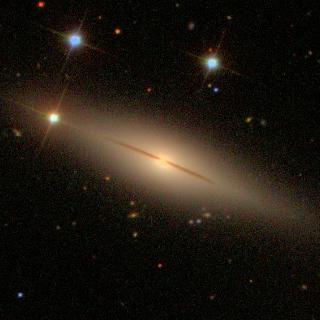

NGC 4753
NGC 4753
, an elliptical galaxy with strange dust filaments. The dust
filaments may be the shredded remains of a small spiral galaxy that was
captured by the much larger elliptical.


NGC 60
NGC 60
, a distant spiral galaxy with unusually distorted spiral arms. Arms like
these normally arise from the gravitational effects of neighbor galaxies, but for
this object there is no obvious neighbor.


NGC 5496
NGC 5496
, another edge-on spiral galaxy.


NGC 936
NGC 936
NGC 936, a nearby barred spiral galaxy.


Spirals
Many of the galaxy images the Sloan Digital Sky Survey has taken are spirals,
like our own Milky Way. Below are some of the most beautiful spiral galaxies that the SDSS has seen.
NGC 1055
NGC 1055
, a nearby spiral seen edge-on. The galaxy has a lot of dust in its disk.


NGC 5750
NGC 3521
NGC 2967
NGC 2967
, which appears nearly face-on.


NGC 5719
UGC 01962
UGC 01962
, a whirlpool-like face-on spiral.


NGC 1087
NGC 1087
, a star forming spiral
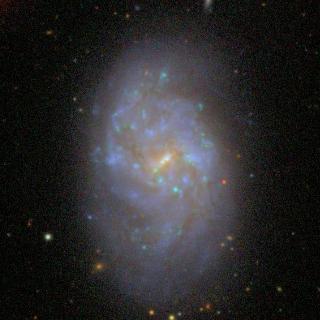

NGC 5334
NGC 5334
a photogenic spiral galaxy.


Clumps
Clumps are loose collections of stars, gas, or galaxies held together by gravity.
Palomar 3
Palomar 3
Palomar 3 (also known as Sextans C) is a globular cluster, a collection of old stars orbiting the Milky Way.


Palomar 5
Globular cluster
Palomar 5
, which is being torn apart by the Milky Way's gravity.


UGCA 285
UGCA 285
, an ultra-low surface brightness galaxy. Galaxies come in a
variety of sizes and luminosities; this galaxy is so faint that even the
SDSS's camera can barely see it.


UGC 07332
UGC 07332
, a nearby, blue, low surface brightness galaxy.


UGC 05205
UGC 05205
and its companion. These two galaxies are very young, full of young, blue hot stars.


NGC 0201
A nearby group of galaxies centered on
NGC 0201
. Galaxy groups typically have about 10-20 members.
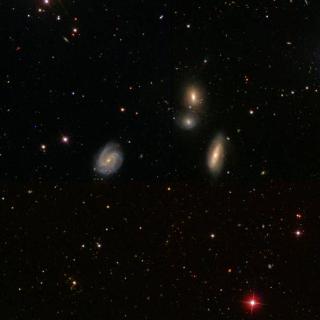

VIII Zw 388
VIII Zw 388
, a picturesque group of galaxies, discovered and catalogued by famous astronomer Fritz Zwicky.
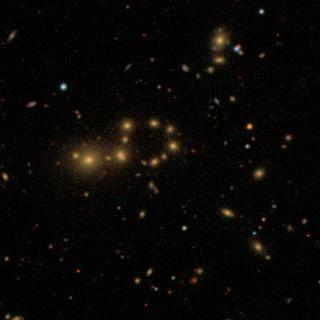

Moderately Red Shifted Galaxies
A cluster of
Red-Shifted Galaxies
moderately far away. One of the major goals of the
SDSS is to learn how galaxies cluster, and to use the clustering to infer the
characteristics of the early universe.


Clusters
Galaxies are found in clusters of hundreds or thousands, held together by their mutual gravity.
One of the SDSS's major goals is to understand how galaxies form clusters and larger structures,
up to the large-scale structure of the universe.
Abell 168
Abell 168
, a nearby cluster of galaxies.


A Rich Cluster
A Rich Cluster
, detected by the SDSS.


Medium Distant Cluster of Galaxies
A
medium distant cluster of galaxies
. The Sloan Survey has detected thousands of galaxy clusters, most of which have never been catalogued.
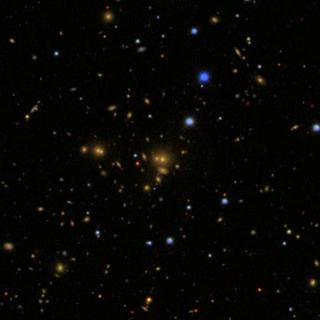

Abell 267
Abell 267
, a distant rich cluster of galaxies.


Three Clusters of Galaxies
The ensemble of faint images is a superposition of
three clusters of galaxies
at different distances along the line of sight. The estimated redshifts of the clusters
are 0.38, 0.43, and 0.50. The different redshifts give rise to slightly different colors in the galaxies, with the most distant objects appearing to be the reddest.


Another Rich Cluster
Another rich cluster
, detected by the SDSS.


Abell 0957
Abell 0957
, a well-known rich cluster, at a redshift of 0.0423, detected by the SDSS.


ZwCl 1710 (Abell 2255)
ZwCl 1710
ZwCl 1710, also known as Abell 2255, a rich cluster, at a redshift 0.081, detected by the SDSS. This cluster was also detected in X-rays.


Interactions
Sometimes, galaxies collide, or pass close enough to affect each other through the force of
gravity. Astronomers call these collisions and forces "interactions" of galaxies. Some
interactions seen by the SDSS are shown below.
ARP 240
ARP 240
, an interacting pair of galaxies. Note how the galaxies have distorted each other through their mutual gravity.
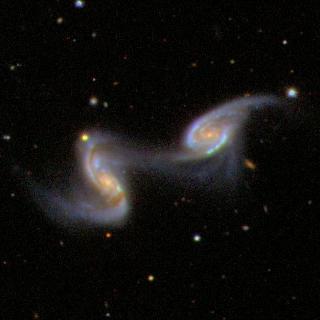

UGC 08584
Another pair of violently interacting galaxies. The brighter object is called
UGC 08584.


NGC 799 & NGC 800
Two well-known spiral galaxies,
NGC 799, and NGC 800, very close together.


NGC 428
NGC 428, a spectacularly blue
nearby spiral galaxy. The blue color indicates very active star formation in this galaxy.


UGC 10770
UGC 10770, a young spiral galaxy,
undergoing a collision. This object is mentioned in many catalogs of interacting galaxies (ARP, etc).


NGC 7603 & PGC 07041
NGC 7603 and PGC 07041
NGC 7603 and PGC 07041, an interacting pair. Notice the "bridge" of stars and gas
between the two galaxies. The bigger object, NGC 7603, is a well-known Seyfert galaxy.
Seyfert galaxies have small, bright, active cores.


UGC 1597
UGC 1597
, a Seyfert galaxy with an active core. Notice the disturbed appearance of the
galaxy. This object may be the remnant of an old collision between two galaxies. As a
by-product of the collision, gas from one galaxy is being dumped onto a black hole at
the center of the other galaxy, giving rise to the active core.


Quasar
The faint reddish object is a distant quasar
(redshift z=5.0).
Quasars are the most luminous objects in the Universe. They consist of a giant
black hole in the center of a host galaxy. This object was the first to exceed
the magic distance threshold of z=5.0.



